spark plugs replace Hyundai Accent 2004 Owner's Manual
[x] Cancel search | Manufacturer: HYUNDAI, Model Year: 2004, Model line: Accent, Model: Hyundai Accent 2004Pages: 205, PDF Size: 3.2 MB
Page 119 of 205
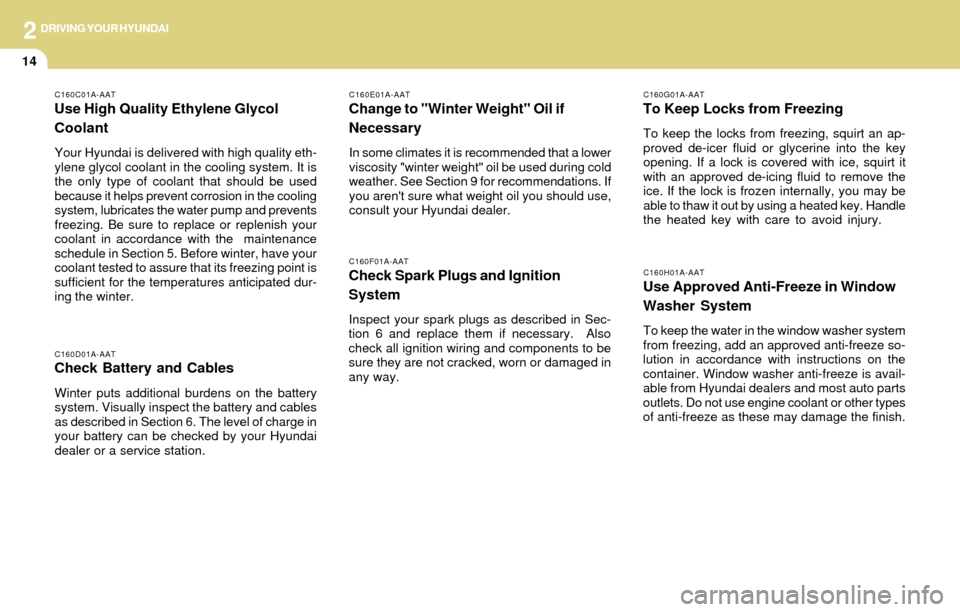
2DRIVING YOUR HYUNDAI
14
C160D01A-AATCheck Battery and Cables
Winter puts additional burdens on the battery
system. Visually inspect the battery and cables
as described in Section 6. The level of charge in
your battery can be checked by your Hyundai
dealer or a service station.
C160E01A-AAT
Change to "Winter Weight" Oil if
Necessary
In some climates it is recommended that a lower
viscosity "winter weight" oil be used during cold
weather. See Section 9 for recommendations. If
you aren't sure what weight oil you should use,
consult your Hyundai dealer.
C160C01A-AAT
Use High Quality Ethylene Glycol
Coolant
Your Hyundai is delivered with high quality eth-
ylene glycol coolant in the cooling system. It is
the only type of coolant that should be used
because it helps prevent corrosion in the cooling
system, lubricates the water pump and prevents
freezing. Be sure to replace or replenish your
coolant in accordance with the maintenance
schedule in Section 5. Before winter, have your
coolant tested to assure that its freezing point is
sufficient for the temperatures anticipated dur-
ing the winter.
C160H01A-AAT
Use Approved Anti-Freeze in Window
Washer System
To keep the water in the window washer system
from freezing, add an approved anti-freeze so-
lution in accordance with instructions on the
container. Window washer anti-freeze is avail-
able from Hyundai dealers and most auto parts
outlets. Do not use engine coolant or other types
of anti-freeze as these may damage the finish.
C160F01A-AAT
Check Spark Plugs and Ignition
System
Inspect your spark plugs as described in Sec-
tion 6 and replace them if necessary. Also
check all ignition wiring and components to be
sure they are not cracked, worn or damaged in
any way.
C160G01A-AAT
To Keep Locks from Freezing
To keep the locks from freezing, squirt an ap-
proved de-icer fluid or glycerine into the key
opening. If a lock is covered with ice, squirt it
with an approved de-icing fluid to remove the
ice. If the lock is frozen internally, you may be
able to thaw it out by using a heated key. Handle
the heated key with care to avoid injury.
Page 144 of 205
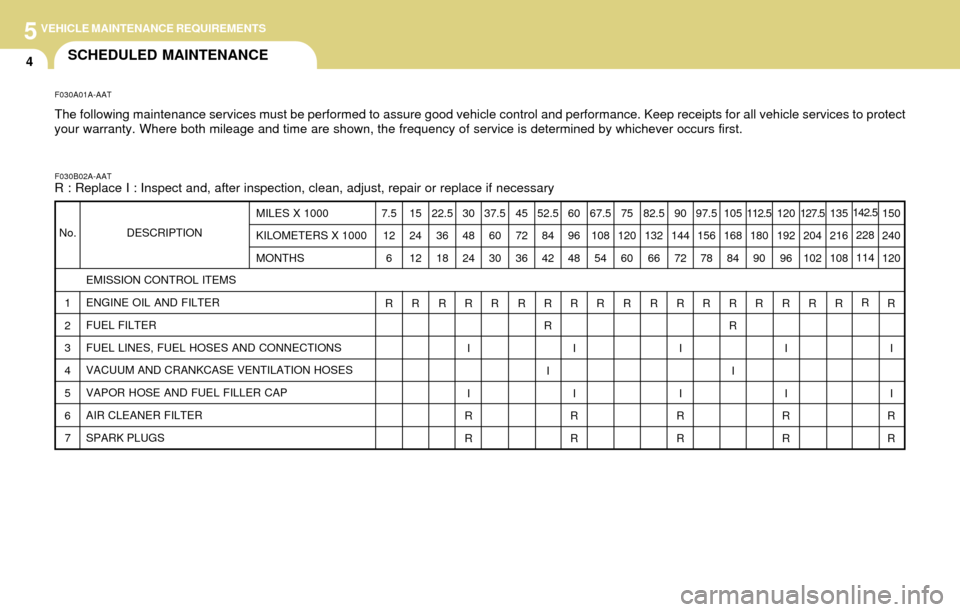
5VEHICLE MAINTENANCE REQUIREMENTS
4SCHEDULED MAINTENANCE
150
240
120
R
I
I
R
R MILES X 1000
KILOMETERS X 1000
MONTHS
EMISSION CONTROL ITEMS
ENGINE OIL AND FILTER
FUEL FILTER
FUEL LINES, FUEL HOSES AND CONNECTIONS
VACUUM AND CRANKCASE VENTILATION HOSES
VAPOR HOSE AND FUEL FILLER CAP
AIR CLEANER FILTER
SPARK PLUGS No.DESCRIPTION
1
2
3
4
5
6
77.5
12
6
R15
24
12
R22.5
36
18
R30
48
24
R
I
I
R
R37.5
60
30
R45
72
36
R52.5
84
42
R
R
I60
96
48
R
I
I
R
R67.5
108
54
R75
120
60
R82.5
132
66
R90
144
72
R
I
I
R
R97.5
156
78
R105
168
84
R
R
I112.5
180
90
R120
192
96
R
I
I
R
R127.5
204
102
R135
216
108
R142.5
228
114
R
F030B02A-AATR : Replace I : Inspect and, after inspection, clean, adjust, repair or replace if necessary
F030A01A-AAT
The following maintenance services must be performed to assure good vehicle control and performance. Keep receipts for all vehicle services to protect
your warranty. Where both mileage and time are shown, the frequency of service is determined by whichever occurs first.
Page 146 of 205
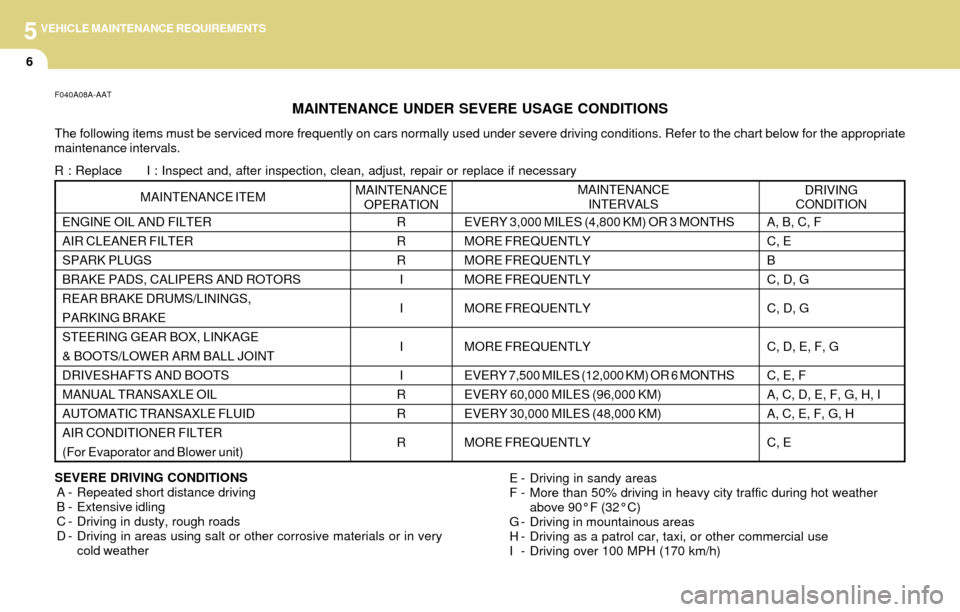
5VEHICLE MAINTENANCE REQUIREMENTS
6
DRIVING
CONDITION MAINTENANCE
INTERVALS
ENGINE OIL AND FILTER
AIR CLEANER FILTER
SPARK PLUGS
BRAKE PADS, CALIPERS AND ROTORS
REAR BRAKE DRUMS/LININGS,
PARKING BRAKE
STEERING GEAR BOX, LINKAGE
& BOOTS/LOWER ARM BALL JOINT
DRIVESHAFTS AND BOOTS
MANUAL TRANSAXLE OIL
AUTOMATIC TRANSAXLE FLUID
AIR CONDITIONER FILTER
(For Evaporator and Blower unit)R
R
R
I
I
I
I
R
R
R MAINTENANCE
OPERATION MAINTENANCE ITEM
EVERY 3,000 MILES (4,800 KM) OR 3 MONTHS
MORE FREQUENTLY
MORE FREQUENTLY
MORE FREQUENTLY
MORE FREQUENTLY
MORE FREQUENTLY
EVERY 7,500 MILES (12,000 KM) OR 6 MONTHS
EVERY 60,000 MILES (96,000 KM)
EVERY 30,000 MILES (48,000 KM)
MORE FREQUENTLY
SEVERE DRIVING CONDITIONS
A - Repeated short distance driving
B - Extensive idling
C - Driving in dusty, rough roads
D - Driving in areas using salt or other corrosive materials or in very
cold weatherE - Driving in sandy areas
F - More than 50% driving in heavy city traffic during hot weather
above 90°F (32°C)
G - Driving in mountainous areas
H - Driving as a patrol car, taxi, or other commercial use
I - Driving over 100 MPH (170 km/h)
F040A08A-AAT
MAINTENANCE UNDER SEVERE USAGE CONDITIONS
The following items must be serviced more frequently on cars normally used under severe driving conditions. Refer to the chart below for the appropriate
maintenance intervals.
R : Replace I : Inspect and, after inspection, clean, adjust, repair or replace if necessary
A, B, C, F
C, E
B
C, D, G
C, D, G
C, D, E, F, G
C, E, F
A, C, D, E, F, G, H, I
A, C, E, F, G, H
C, E
Page 147 of 205
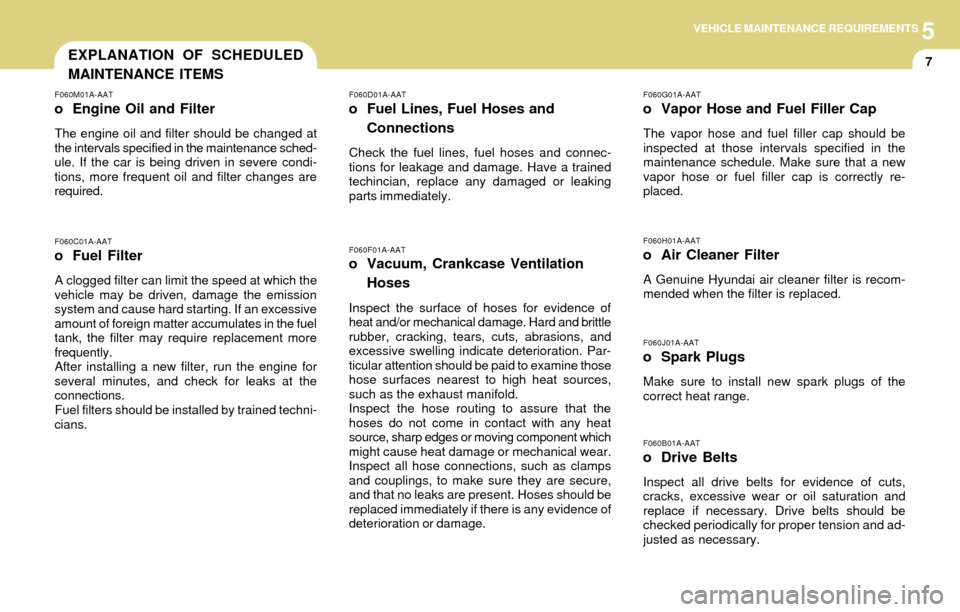
5VEHICLE MAINTENANCE REQUIREMENTS
7EXPLANATION OF SCHEDULED
MAINTENANCE ITEMS
F060D01A-AAT
o Fuel Lines, Fuel Hoses and
Connections
Check the fuel lines, fuel hoses and connec-
tions for leakage and damage. Have a trained
techincian, replace any damaged or leaking
parts immediately.
F060C01A-AATo Fuel Filter
A clogged filter can limit the speed at which the
vehicle may be driven, damage the emission
system and cause hard starting. If an excessive
amount of foreign matter accumulates in the fuel
tank, the filter may require replacement more
frequently.
After installing a new filter, run the engine for
several minutes, and check for leaks at the
connections.
Fuel filters should be installed by trained techni-
cians.
F060M01A-AAT
o Engine Oil and Filter
The engine oil and filter should be changed at
the intervals specified in the maintenance sched-
ule. If the car is being driven in severe condi-
tions, more frequent oil and filter changes are
required.
F060H01A-AAT
o Air Cleaner Filter
A Genuine Hyundai air cleaner filter is recom-
mended when the filter is replaced.
F060G01A-AAT
o Vapor Hose and Fuel Filler Cap
The vapor hose and fuel filler cap should be
inspected at those intervals specified in the
maintenance schedule. Make sure that a new
vapor hose or fuel filler cap is correctly re-
placed.
F060F01A-AATo Vacuum, Crankcase Ventilation
Hoses
Inspect the surface of hoses for evidence of
heat and/or mechanical damage. Hard and brittle
rubber, cracking, tears, cuts, abrasions, and
excessive swelling indicate deterioration. Par-
ticular attention should be paid to examine those
hose surfaces nearest to high heat sources,
such as the exhaust manifold.
Inspect the hose routing to assure that the
hoses do not come in contact with any heat
source, sharp edges or moving component which
might cause heat damage or mechanical wear.
Inspect all hose connections, such as clamps
and couplings, to make sure they are secure,
and that no leaks are present. Hoses should be
replaced immediately if there is any evidence of
deterioration or damage.
F060B01A-AAT
o Drive Belts
Inspect all drive belts for evidence of cuts,
cracks, excessive wear or oil saturation and
replace if necessary. Drive belts should be
checked periodically for proper tension and ad-
justed as necessary.
F060J01A-AAT
o Spark Plugs
Make sure to install new spark plugs of the
correct heat range.
Page 150 of 205
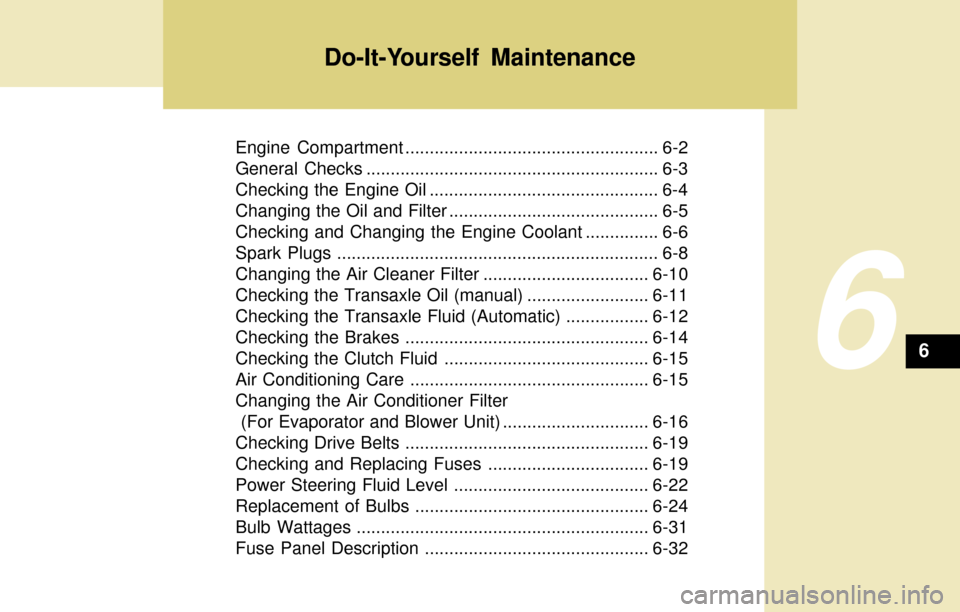
Engine Compartment .................................................... 6-2
General Checks ............................................................ 6-3
Checking the Engine Oil ............................................... 6-4
Changing the Oil and Filter ........................................... 6-5
Checking and Changing the Engine Coolant ............... 6-6
Spark Plugs .................................................................. 6-8
Changing the Air Cleaner Filter ..................................6-10
Checking the Transaxle Oil (manual) .........................6-11
Checking the Transaxle Fluid (Automatic) .................6-12
Checking the Brakes ..................................................6-14
Checking the Clutch Fluid ..........................................6-15
Air Conditioning Care .................................................6-15
Changing the Air Conditioner Filter
(For Evaporator and Blower Unit) ..............................6-16
Checking Drive Belts ..................................................6-19
Checking and Replacing Fuses .................................6-19
Power Steering Fluid Level ........................................6-22
Replacement of Bulbs ................................................6-24
Bulb Wattages ............................................................6-31
Fuse Panel Description ..............................................6-32
Do-It-Yourself Maintenance
66
Page 157 of 205
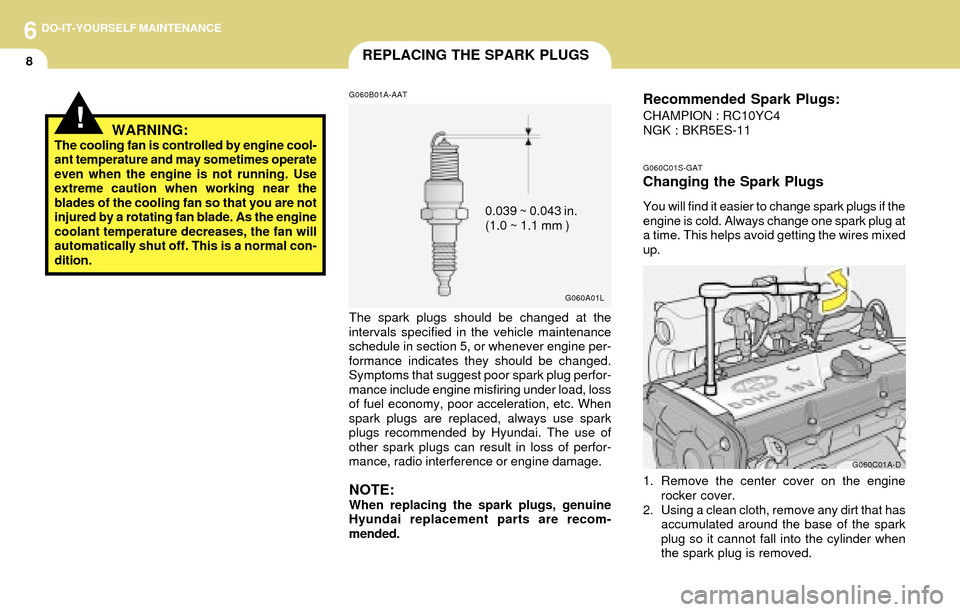
6DO-IT-YOURSELF MAINTENANCE
8REPLACING THE SPARK PLUGS
G060B01A-AAT
G060A01L
0.039 ~ 0.043 in.
(1.0 ~ 1.1 mm )
The spark plugs should be changed at the
intervals specified in the vehicle maintenance
schedule in section 5, or whenever engine per-
formance indicates they should be changed.
Symptoms that suggest poor spark plug perfor-
mance include engine misfiring under load, loss
of fuel economy, poor acceleration, etc. When
spark plugs are replaced, always use spark
plugs recommended by Hyundai. The use of
other spark plugs can result in loss of perfor-
mance, radio interference or engine damage.
NOTE:When replacing the spark plugs, genuine
Hyundai replacement parts are recom-
mended.
G060C01S-GATChanging the Spark Plugs
You will find it easier to change spark plugs if the
engine is cold. Always change one spark plug at
a time. This helps avoid getting the wires mixed
up.
G060C01A-D
1. Remove the center cover on the engine
rocker cover.
2. Using a clean cloth, remove any dirt that has
accumulated around the base of the spark
plug so it cannot fall into the cylinder when
the spark plug is removed.
Recommended Spark Plugs:CHAMPION : RC10YC4
NGK : BKR5ES-11!WARNING:The cooling fan is controlled by engine cool-
ant temperature and may sometimes operate
even when the engine is not running. Use
extreme caution when working near the
blades of the cooling fan so that you are not
injured by a rotating fan blade. As the engine
coolant temperature decreases, the fan will
automatically shut off. This is a normal con-
dition.
Page 158 of 205

6DO-IT-YOURSELF MAINTENANCE
9
!WARNING:It is recommended that the engine be cool or
cold when changing the spark plugs. If the
engine is hot, you could burn yourself on the
insulated connector, the spark plug or the
engine itself.
G060C02A-D
4. When preparing to remove the old spark
plug, guide the socket down over the spark
plug, being careful not to damage the ce-
ramic insulator.
6. To install the new spark plug, guide the
socket down over the spark plug, being care-
ful not to damage the ceramic insulator.
5. To remove the old spark plug, turn the wrench
handle in a counterclockwise direction.
G060C03A-D
3. To remove the spark plug cable, pull straight
up on the insulated connector, not the cable.
Pulling on the cable may damage the carbon
core conductor.
NOTE:Spark plugs should be tightened firmly. Over-
tightening can damage the threads in the
aluminum cylinder head. Also, leaving them
too loose can cause the spark plugs to get
very hot and possibly result in damage to the
engine.
7. Replace the cable by pushing the insulated
connector directly down onto the electrode.
Check to be sure it has snapped into place
and can't fall off.
G060C04A-D
Page 204 of 205
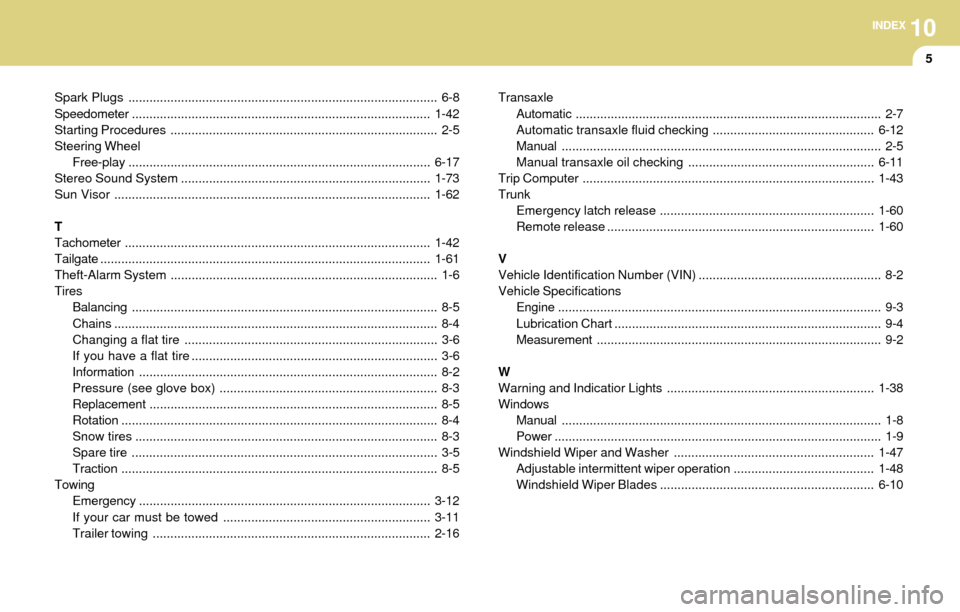
10INDEX
5
Spark Plugs........................................................................................ 6-8
Speedometer.....................................................................................1-42
Starting Procedures ............................................................................ 2-5
Steering Wheel
Free-play......................................................................................6-17
Stereo Sound System .......................................................................1-73
Sun Visor..........................................................................................1-62
T
Tachometer.......................................................................................1-42
Tailgate..............................................................................................1-61
Theft-Alarm System............................................................................ 1-6
Tires
Balancing....................................................................................... 8-5
Chains............................................................................................ 8-4
Changing a flat tire ........................................................................ 3-6
If you have a flat tire ...................................................................... 3-6
Information..................................................................................... 8-2
Pressure (see glove box) .............................................................. 8-3
Replacement.................................................................................. 8-5
Rotation.......................................................................................... 8-4
Snow tires...................................................................................... 8-3
Spare tire ....................................................................................... 3-5
Traction.......................................................................................... 8-5
Towing
Emergency...................................................................................3-12
If your car must be towed ...........................................................3-11
Trailer towing ...............................................................................2-16Transaxle
Automatic....................................................................................... 2-7
Automatic transaxle fluid checking..............................................6-12
Manual........................................................................................... 2-5
Manual transaxle oil checking.....................................................6-11
Trip Computer ...................................................................................1-43
Trunk
Emergency latch release .............................................................1-60
Remote release ............................................................................1-60
V
Vehicle Identification Number (VIN) .................................................... 8-2
Vehicle Specifications
Engine............................................................................................ 9-3
Lubrication Chart ............................................................................ 9-4
Measurement................................................................................. 9-2
W
Warning and Indicatior Lights ...........................................................1-38
Windows
Manual........................................................................................... 1-8
Power............................................................................................. 1-9
Windshield Wiper and Washer .........................................................1-47
Adjustable intermittent wiper operation ........................................1-48
Windshield Wiper Blades.............................................................6-10